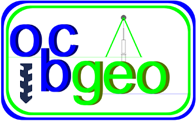
Example of rock core recovered, photographed and logged
Rotary Drilling techniques are used where boreholes are required to penetrate through very stiff or very dense soils or into bedrock. Rotary Coring allows for lengths of rock core to be extracted and geotechnically logged and tested.
OCB Geotechnical currently operate a Socomafor 50/65 Rotary rig.
Rotary Drilling can be subdivided into Rotary Open Hole drilling and Rotary Coring methods.
Open hole drilling allows for penetration down through otherwise impenetrable (with Cable Percussion techniques) hard strata such as boulder clay. This technique is used to reach solid bedrock in order to begin Rotary Coring or even to drill through the bedrock itself, not recovering samples, in cases where the precise geotechnical properties of the rock is not required.
When Rotary Coring is undertaken, rock samples can be recovered and placed in triple channel core boxes of 1m length. These core boxes are subsequently photographed and the rock logged by a qualified Geotechnical Engineer and can be subsampled for laboratory testing. The engineer will measure the geotechnical characteristics of the rock core including; Total Core Recover (TCR), Solid Core Recovery (SCR), Rock Quality Designation (RQD), Fracture Index, rock type (lithology), discontinuity characteristics and the degree of weathering. These parameters along with geotechnical laboratory results allow for the engineering characteristics of the rock to be determined for input to design. Detailed geotechnical logs are prepared by an engineer using AGS compatible software such as HoleBASE SI.
OCB Geotechnical can produce interpretative reports outlining the rock mass characteristics and suggest design requirements if required. This allows for accurate planning of foundation design, earthworks, slope stability etc.
All fieldwork carried out in accordance with the relevant British Standards: BS 5930
